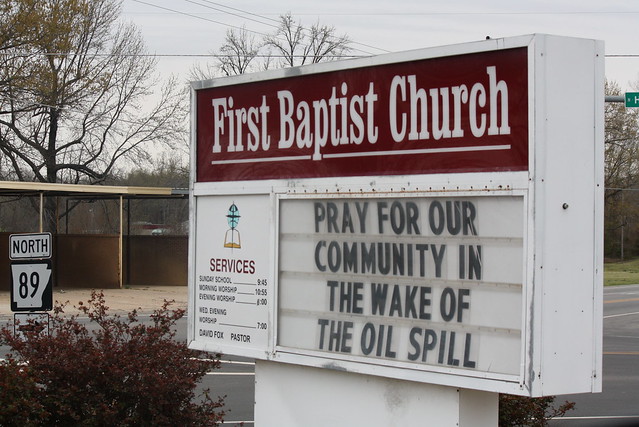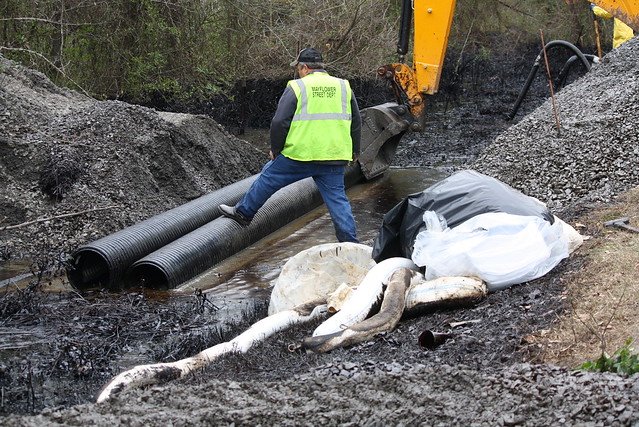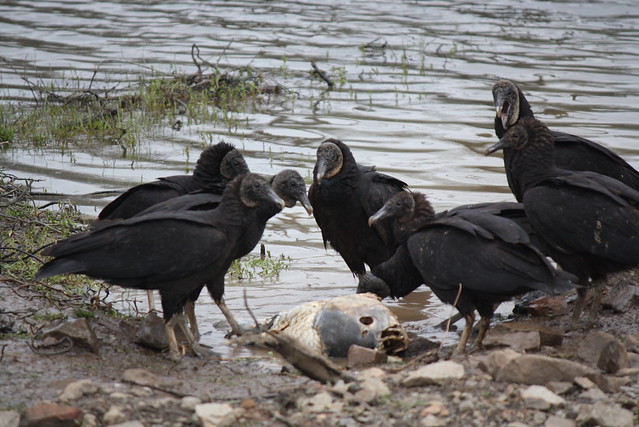
Intro from Lee Ziesche, Grassroots Coordinator and post from April Lane, Arkansas organizer:

Arkansas is feeling the full effects of being an extractive energy state. It’s been rocked by earthquakes and covered in oil, yet often does not get the same attention as states like Pennsylvania or Texas. Even within the fracking movement.
That’s why our grassroots tours are so important. They give us a chance to visit some of the most impacted areas and talk to the people who are often out of the spotlight. And then share their stories with you.
Josh and I had heard about the Mayflower Oil Spill, but didn’t know the full devastating effects until we went to Arkansas to screen Gasland Part II and talked to those on the front lines who are seeing the environmental and health impacts up close.
Below is a post about the spill from April Lane. a leading organizer in Arkansas.
Not From Gasland Journal: The Mayflower Oil Spill
It has now been a little over six months since the Exxon Pegasus Pipeline ruptured in Mayflower, AR flooding the community with over 250,000 plus gallons of Wabasca Heavy Crude oil, a type of oil mined very closely to Tar Sands in Alberta, Canada. Wabasca Heavy Crude is a highly toxic substance known as bitumen. Because the bitumen is so heavy, it must be diluted with lighter hydrocarbons like Benzene to allow flow through a pipeline. The final product after dilution is known as “dilbit.”
There is much we now know about the Pegasus Pipeline and dilbit it carries. We know that Pegasus is a “vintage” pipeline that is not adequately equipped to carry such a product. We know through the independent air monitoring we performed that there were upwards of 30 chemicals in the air circulating near neighborhoods, schools and shopping centers after the pipeline rupture. We know that many of those chemicals are very harmful to human health. Benzene, Toluene, Ethyl benzene and Xylene are among some of the more highly toxic and carcinogenic chemicals in the pipeline. Each of these chemicals are toxic on their own and are even more harmful when they interact with each other synergistically as well as cumulatively. And one major problem is that there is little research on a vast majority of these chemicals and little to none on how they are exacerbated once combined.

First responders work desperately to build barricades to keep the oil from overwhelming Lake Conway.
In a recent article by the Arkansas Democrat Gazette, the Arkansas Department of Environmental Quality released a statement about the toxins they found in the area of Lake Conway referred to as “The Cove,” where the majority of the oil was diverted. This statement professes in little detail that the compounds they detected were not a risk to human health but that there are ecological concerns. On August 16th, nearly five months after the pipeline rupture and spill, one Volatile Organic Compound and 11 toxic Polynuclear Aromatic Hydrocarbons were detected; the most toxic of those is benzo-pyrene.
The fact is that if there is an ecological concern there also is a human health concern. Humans are certainly a part of the ecology. For the state of Arkansas to say that there is no risk from consuming the fish from Lake Conway, and that there is “minimal to no” risk to humans is unacceptable. The toxins that were spilled into the environment can be ingested and absorbed by fish and other wildlife and can bio-accumulate and very easily cause a negative impact to species, including humans, that eat fish and other wildlife from Lake Conway or the surrounding, impacted areas.

The damage to the Lake can be seen by merely looking at the wildlife that used to call it home.
The state also maintains that no evidence of oil has been found in the main body of Lake Conway despite residential sightings of sheen as well as the fact that the cove and main body of the Lake are only separated by a drainage ditch and a road. They are hydraulically connected. In addition to being naturally connected through underground channels, contaminated water from the cove was pumped into the main body of Lake Conway several times after the rupture. The risk of contamination is high and will continue to get higher as the sediment continues to accumulate more of these toxins and as the surrounding wildlife continue to cross-contaminate the area.
These agencies are making these determinations of the effects based on the concentrations being detecting in the air, water and soil. But how are they making these determinations? They are looking at raw data and saying that the detections are below levels, “likely to cause an impact.” They are using standards that are developed by testing these chemicals on animals and we have by no means tested them all. In order to assess whether the standards are appropriate to identifying human health effects we must collect information from the community using a comprehensive health assessment. If these standards are not appropriate and need to be altered to further protect human health then assessing is the only way to determine that. To date, no state or federal agency has begun assessing communities that have been subject to an oil spill.
If we simply look back at history we can draw from many instances in which regulatory agencies and corporations deemed something safe and unlikely to impact humans that years later we found to be disastrously harmful to public health. In fact, all you need to do is turn on your television to see the latest drug being recalled and the onslaught of legal ads soliciting citizens who may have fallen victim to this or that FDA approved drug. Smoking cigarettes was deemed safe for decades until finally appropriately labeled as cancer-causing. It is no secret that we cannot continue to solely rely on our government and our regulatory agencies to police the very companies that overwhelm them with money, lawsuits and lobbyists. That is why many of us throughout communities across America have picked up the slogan, “If not us, who? If not now, when?”

The signs of contamination are clear to everyone who lives near the water and has seen the evidence of oil drenching the banks.
Since the rupture, Faulkner County Citizens Advisory Group, a non-profit community group whose Board I serve on, have put out advisories and press releases informing the community of this highly toxic exposure and that they are at risk of developing short and long-term health effects. FCCAG enlisted the support of scientists to aid in understanding the severity of the situation. Environmental scientist Dr. Wilma Subra, who is a recipient of the MacArthur Genius award, and Dr. Riki Ott, a marine toxicologist who worked very closely with residents after the Exxon Valdez spill, both visited our community for the first Town Hall even that FCCAG hosted for the residents of Mayflower. Our hope was to get these experts in the same space as residents, as well as state and local officials, so that we could all be educated at the same time about the risks from the spill. This was an important opportunity for state officials and agencies as Arkansas has never dealt with this type of chemical spill. Unfortunately, though, very few local and state officials attended this important event, even though it was highly publicized and they were personally invited. FCCAG has hosted six Town Halls since the pipeline rupture, and still there have been very little involvement by local and state officials.
FCCAG’s main organizational mission is to connect local authorities and residents who have concerns. However, since the spill, and despite our efforts, there remains a vast communication gap between the decision makers and those who have suffered from the oil spill. A mentality of “act first, ask questions later, or never” quickly emerged. We do not know or understand why the Unified Command and local state agencies such as the Arkansas Department of Health did not hold additional public meetings in order to inform residents and document their symptoms and concerns.
There is also a clear disconnect between Arkansas’s officials and those in places like Kalamazoo, Michigan where similar substances have been spilled. There has been no attempt by Arkansas to connect to other communities that have suffered similar spills, so our state is missing out on an important opportunity to learn and to properly remediate. Fortunately, FCCAG and Mayflower residents have made connections to Kalamazoo and the Gulf Coast. From these communications, we have learned that they have experienced many of the same things that we are experiencing now in Arkansas: a lack of communication from state agencies, cookie cutter answers and newsletters pumped out by the responsible party, and a lack of investigative reporting by local media outlets. Residents in all of these communities continue to ask why more precautionary steps have not been taken to prevent such disasters and why residents have not been given relevant information to make their own decisions, especially regarding health treatment options.

Workers were just as severely affected as they attempt to clean up what many experts say is impossible to fully remove
We do not know why the evacuated area, labeled as the “impact zone,” was limited only to the Northwoods subdivision and did not encompass the entire residential area where many people were immediately exposed, and immediately experienced health effects. We do not know why only the residents of the subdivision were allowed into the first meeting held by Unified Command when this event clearly impacted the entire community. Why were the residents not informed of the risks using public service announcements? Why was the community as a whole not instructed to contact the Department of Health as well as the Poison Control Center and given criteria to determine their exposure? These few questions merely scratch the surface of what has unfolded in the rural community of Mayflower. Most questions remain unanswered and many things have yet to be investigated.
For many months, concerned community members and FCCAG have been trying to assist effected residents in how to best address their health symptoms which include regulatory organ problems, skin rashes, boils, internal bleeding, nausea, chronic headaches, loss of appetite, metallic tastes on their tongues, and many other symptoms.
One conclusion I have drawn is that we as a state and a nation are failing our people. We are failing communities like Mayflower, AR and Kalamazoo, MI, and we will undoubtedly fail many more if we continue to allow large corporations to pump these undisclosed, highly toxic substances underneath our feet. It should be mandatory for these companies to perform human impact studies so that we know what we and our children may be exposed to. To not require this is unacceptable and may severely impact our ability to live as productive human beings. We have an innate human right to flourish in our communities without a corporation dumping toxic waste in it, destroying it in a matter of minutes, never to fully recover. So where do we go from here? What do we do? Well there is one answer, we unite!
This is the United States of America and it is time that we send a message to agencies and elected officials that we are taking back our rights and refuse to allow incidents such as this to continue happening. Furthermore, we refuse to allow our state and federal agencies charged with protecting us to disengage from our communities and allow a multi-billion dollar corporation to turn its back on the people they injured. This is not over and the work has just begun in identifying what the impact to Mayflower, AR has been and will be in the coming years. It is time for all hands on deck.
“Those who have the privilege to know, have the duty to act.” – Albert Einstein
In Service,
April Lane
Project Director, Faulkner County Bucket Brigade
Board member, Faulkner County Citizens Advisory Group
Co-Director, ArkansasFracking.org
President, UCA Environmental Alliance



Follow Us: